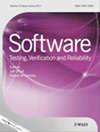深度神经网络的不确定性量化:经验比较和使用指南
IF 1.2
4区 计算机科学
Q3 COMPUTER SCIENCE, SOFTWARE ENGINEERING
引用次数: 5
摘要
深度神经网络(DNN)越来越多地被用作需要处理复杂数据(如图像、书面文本、音频/视频信号)的大型软件系统的组件。由于几个原因,不能假设DNN预测总是正确的,其中包括处理的巨大输入空间,一些输入数据的模糊性,以及学习算法的内在属性,这些只能提供统计保证。因此,开发人员必须处理一些残余错误概率。通常用于管理容易发生故障的组件的架构模式是监督器,这是一个额外的组件,可以估计不受信任(例如DNN)组件所做预测的可靠性,并可以在这些组件可能失败时激活自动修复程序,确保基于深度学习的系统(DLS)不会造成损害,尽管其主要功能被暂停。本文章由计算机程序翻译,如有差异,请以英文原文为准。

Uncertainty quantification for deep neural networks: An empirical comparison and usage guidelines
Deep neural networks (DNN) are increasingly used as components of larger software systems that need to process complex data, such as images, written texts, audio/video signals. DNN predictions cannot be assumed to be always correct for several reasons, amongst which the huge input space that is dealt with, the ambiguity of some inputs data, as well as the intrinsic properties of learning algorithms, which can provide only statistical warranties. Hence, developers have to cope with some residual error probability. An architectural pattern commonly adopted to manage failure prone components is the supervisor, an additional component that can estimate the reliability of the predictions made by untrusted (e.g., DNN) components and can activate an automated healing procedure when these are likely to fail, ensuring that the deep learning‐based system (DLS) does not cause damages, despite its main functionality being suspended.
求助全文
通过发布文献求助,成功后即可免费获取论文全文。
去求助
来源期刊

Software Testing Verification & Reliability
工程技术-计算机:软件工程
CiteScore
3.70
自引率
0.00%
发文量
34
审稿时长
>12 weeks
期刊介绍:
The journal is the premier outlet for research results on the subjects of testing, verification and reliability. Readers will find useful research on issues pertaining to building better software and evaluating it.
The journal is unique in its emphasis on theoretical foundations and applications to real-world software development. The balance of theory, empirical work, and practical applications provide readers with better techniques for testing, verifying and improving the reliability of software.
The journal targets researchers, practitioners, educators and students that have a vested interest in results generated by high-quality testing, verification and reliability modeling and evaluation of software. Topics of special interest include, but are not limited to:
-New criteria for software testing and verification
-Application of existing software testing and verification techniques to new types of software, including web applications, web services, embedded software, aspect-oriented software, and software architectures
-Model based testing
-Formal verification techniques such as model-checking
-Comparison of testing and verification techniques
-Measurement of and metrics for testing, verification and reliability
-Industrial experience with cutting edge techniques
-Descriptions and evaluations of commercial and open-source software testing tools
-Reliability modeling, measurement and application
-Testing and verification of software security
-Automated test data generation
-Process issues and methods
-Non-functional testing
 求助内容:
求助内容: 应助结果提醒方式:
应助结果提醒方式:


